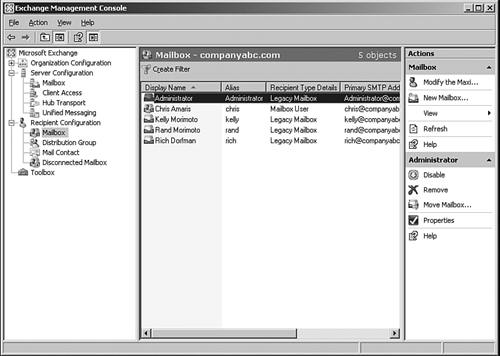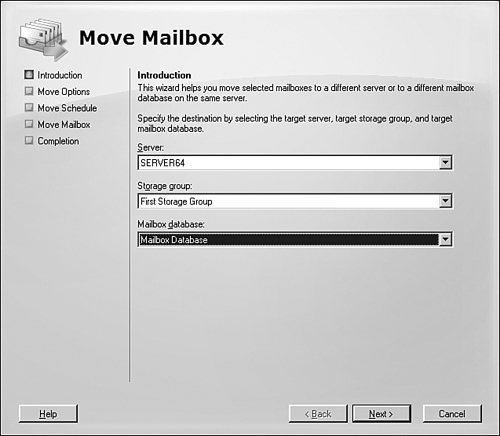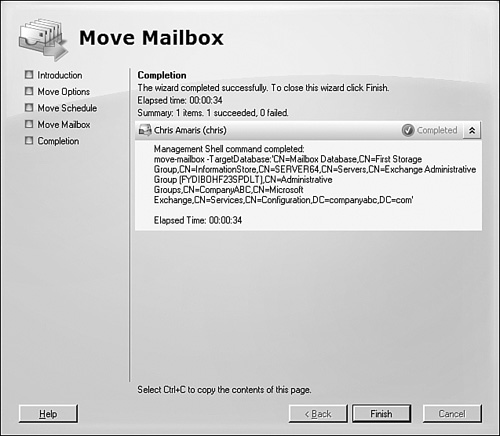Moving Mailboxes
After
a new Exchange 2007 server has been inserted into an existing Exchange
2000 or 2003 organization, the movement of mailboxes from an old
Exchange back-end server to a new Exchange 2007 Mailbox server is as
simple as selecting the mailbox or mailboxes, and through a few mouse
clicks, selecting the new destination server. The specific process is
as follows:
1. | Launch the Exchange Management Console (EMC) on an Exchange 2007 server.
|
2. | Expand
the recipient configuration, and click on the mailbox container. You
will see a list of mailboxes similar to the one shown in Figure 5.
In the Recipient Type Details column, you will notice some of the
mailboxes are flagged as Legacy Mailbox and some of the mailboxes are
flagged as Mailbox User. Those flagged as Legacy Mailbox are still on
Exchange 2000 or 2003 and need to be migrated to Exchange 2007. Those
mailboxes already on Exchange 2007 are flagged as Mailbox User.

|
3. | Click
on a mailbox, or alternately hold down the Shift key and select a group
of mailboxes, or hold down the Ctrl key and click on specific mailboxes
that you want to migrate.
|
4. | Click on the Move Mailbox action in the right column.
|
5. | A
Move Mailbox Wizard appears and you are prompted with the option of
choosing which server, storage group, and mailbox database you want to
move the mailbox to, as shown in Figure 6. Choose the destination of the mailbox(es), and then click Next.

|
6. | You
are prompted with a Move Options screen to choose to Skip the Mailbox
or to Skip the Corrupted Messages if corrupted messages are found
during the move process. Usually, you would want to choose to skip the
corrupt messages so you can complete the migration; however, if you
want to problem-solve the corrupt messages, you can skip the migration
of the mailbox, and then debug the mailbox problem and try the
migration of the mailbox later. Click Next to continue.
|
7. | The
next screen is to choose to select a Move Schedule. You can choose to
move the mailboxes immediately, or choose to launch the migration of
the mailboxes at a later time. Some administrators set up the movement
of mailboxes during the day, and then choose a time later in the
evening for the mailbox migration to automatically kick off when
everyone is off the network. Click Next to continue.
|
8. | A
summary screen is shown that summarizes the choices made. Review the
source and destination of the mailboxes that will be moved, and either
click Back and make any desired changes, or click Move to begin the
movement of mailboxes to the Exchange 2007 environment.
|
9. | The
move time will vary based on the amount of data to be moved, and the
bandwidth between the source and destination server. This is something
that should be tested in the lab to determine whether all of the
mailboxes desired to be moved at any one time can be accomplished in
the time available. Organizations with a lot of data to move choose to
install gigabit Ethernet adapters in servers and place systems on the
same subnet to efficiently move large sets of data. This is also
something to ensure if mirrored in the test environment as some
organizations test the movement of mail on an isolated gigabit test lab
switch with fast results, and then when performing the real migration,
are working across a slower WAN backbone with very slow performance
speeds. After the Move Mailbox Wizard opens the source, opens the
destination, and successfully moves the chosen mailboxes, a summary
screen of the completed actions appears, as shown in Figure 7. Click Finish.
|

Even
after the Exchange mailboxes have been successfully moved from the old
Exchange 2000 or 2003 server(s) to the new Exchange 2007 server(s),
keep the old Exchange 2000 or 2003 servers running on the network for
typically 2 weeks. The reason is that in Outlook 97, 2000, XP, and
2003, the Outlook profile on each user’s system is keyed to a server,
in this case the old Exchange 2000 or 2003 server. If you remove the
old server immediately after the mailboxes are moved, the next time the
users launch Outlook, their profiles will look for the old server, not
find the server, and the users will not have access to email. You will
need to go to each user’s Outlook profile and enter in the name of the
new server so that the Outlook client will be able to find the new
Mailbox server where the user’s mailbox contents are stored.
However,
if you leave the old server running, when the user launches Outlook,
the Outlook profile connects the user to the old Exchange 2000 or 2003
server. The old server tells the Outlook client that the user’s mailbox
has been moved to a new server and the user’s profile is automatically
updated on each user’s client system to now find the user’s mailbox on
the new server. When this is done once for each user, it never needs to
be done again. The user’s Outlook client profile is set to find the
user’s mailbox on the new server. The idea of leaving the old server
running for 2 weeks is usually within a couple of weeks, all users will
have launched Outlook once and their profile will automatically change.
If
a user had not launched Outlook in the 2-week timeframe that you had
the old server running, such as the individual on maternity leave, on a
sabbatical, or on an extended leave of absence, you will need to go
back to the user’s system and manually change the user’s Outlook
profile to connect the user to the new Exchange 2007 server. This will
likely be done for a very limited number of users. Obviously, the old
Exchange 2000 or 2003 server can remain on for a very long time with no
mailboxes on the system, but merely be there to redirect users to the
new system. However, it is usually recommended to remove the old server
just so that objects can be removed from Exchange and the organization
doesn’t have to patch, maintain, and manage a server in the environment
beyond a reasonable operating timeframe.